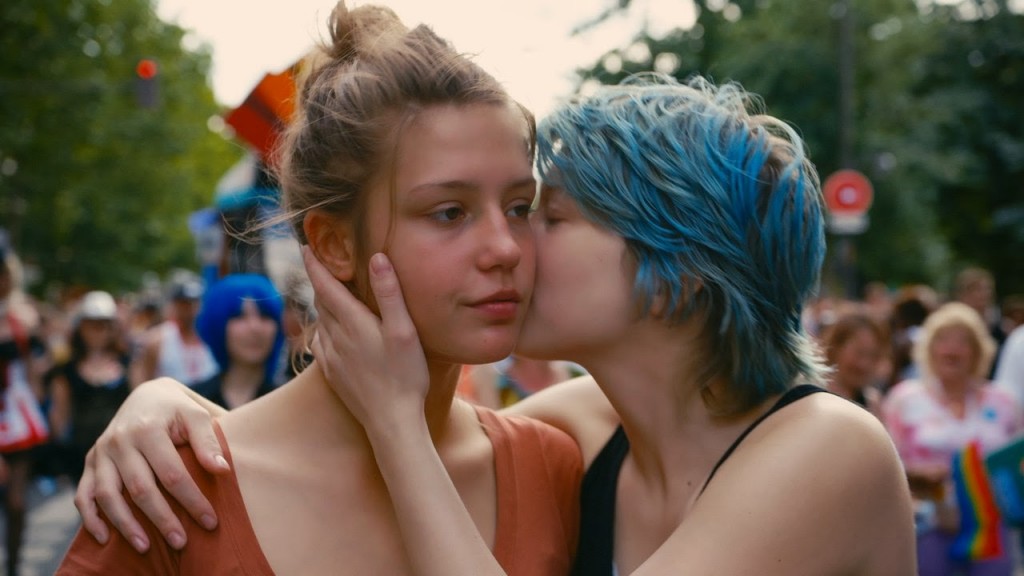Reviews
Movie review: “Blue is the Warmest Color”

Blue is the Warmest Color
dir. Abdellatif Kechiche
Release Date: Nov 01, 13
- 1
- 2
- 3
- 4
- 5
- 6
- 7
- 8
- 9
- 10
Blue is the Warmest Color starts with a life-changing glance, and thereafter concerns itself with so many others over an indeterminate, lengthy stretch of time. While walking to school one day, Adele (Adele Exarchopolous) crosses paths with Emma (Lea Seydoux) on the street. As beguiled by Emma’s shock-blue hair as by her holding hands with another woman, Adele can’t forget Emma. She can’t forget her when she goes to school, when she sleeps, when she pleasures herself or when she attempts to find pleasure with boys. She can’t forget Emma when she decides to voyage into a lesbian bar and finds the woman with the blue hair again, or when they fall for one another, or when they may well fall apart. And all of this is seen in glances, in the almost imperceptible thoughts that cross over a face when a lot is on the mind.
With Blue is the Warmest Color, Abdellatif Kechiche has made a masterpiece. Setting aside the legion of external conflicts related to the film’s production and to its leads’ issues with Kechiche (and vice versa), this is a film which understands that love does not end with the first kiss, nor is it composed solely of dramatic gestures of passion. The film has those as well, quite often in fact, but it also approaches its subject with a scope nearly unprecedented in modern cinema. Before it was a film, Blue is the Warmest Color was a graphic novel by Julie Maroh, with a more direct title: La Vie d’Adele, or rather The Life of Adele. And while Adele’s relationship with Emma forms the spine of the film, this is less about a love story and more about the role that story plays in a young woman’s coming of age.
Exarchopolous is, tropes be damned, a revelation as Adele. From her beginnings as a demure, bookish young high schooler to a slightly more assured, post-collegiate teacher, Exarchopolous is tasked with capturing Adele’s full emotional evolution, up to a certain point. And though she’s occasionally fearful of these new emotions (“I can’t expose myself to the world,” Adele says explicitly about her writing and implicitly about her newly fluid sexuality), she nevertheless approaches life with a sense of wonder that makes her trajectory in the film’s second half all the more devastating. When she’s forced to learn that finding yourself doesn’t necessarily obligate other people to wait along while you do, she collapses into herself. The film’s final shot, indeed, suggests that Adele may know no more about herself at the end of the film’s three hours than she did at the start.
Emma, in many ways, is Adele’s opposite; other than their feverish lust for one another (more on that particular pink elephant in a moment), Emma is as sure of herself as Adele isn’t, perhaps to a fault. Emma knows what she wants out of life, and though Adele becomes part of that plan, whether she stays part of it is really incidental. Emma has already lived through what Adele is living through, and on the other side of all that uncertainty, she wants to get on with life. Kechiche is empathetic to both, never making Adele too much a victim or Emma too jaded. He, and the film, understand that one of the major components of true love is one of its most unsung: the effort it takes to keep love alive once the honeymoon phase ends.
That honeymoon phase, though, features some of the most truly passionate, sensual, rapturous images of love you’ll see in a theater, in this or any other year. Though the sex is explicit, it’s not nearly as tawdry as you’ve probably heard. Like every other part of a fresh relationship, the sex starts off rabid and awkward, bodies stumbling over one another as though there’ll never be enough. Then it becomes more assured and more skillful, and then, after more time, it becomes perfunctory, something that happens when one or both parties aren’t too tired or stressed for the deed. Everything in Blue is the Warmest Color, even the much-heralded sexuality, is seen not as a definitive moment, but rather as a progression.
Above all, Blue is the Warmest Color feels real in a way that almost exists in counter to what cinema as a medium was created to accomplish. It has not just the most interesting and cinematic beats, though it has those in scores, but also all the other stuff, the little indicators that a relationship is content or struggling or perfect or collapsing. And patiently, Kechiche observes his actresses as they fall in and out of love, understanding that neither of those states can ever be absolute. Blue is the Warmest Color is not only one of this year’s very best films, but it is also a towering achievement for both queer cinema and for what movies can be in an increasingly cynical marketplace. It’s impossible to walk out of the theater in anything other than a rapturous state.